By: Terry Lackmeyer, My Pet’s Brace Customer Service Representative
When a dog incurs an injury, sometimes x-rays are taken to get the “inside” scoop on exactly what’s going on with that injury. Does that mean that we need to see x-rays to make a leg brace for your dog? Well, it depends on the injury.
If your dog has a Cranial  Cruciate Ligament (CCL/ACL) injury, the injured ligament will not show up on x-rays. However, your vet may take X-rays of the knee because they want to rule out other possibilities. They may be looking to see if your dog has arthritis, a tumor, or cancer. Once they see that there is nothing else lurking in your dog’s knee and they have gotten a positive result on what is called a “drawer test” on your dog’s leg, they can feel comfortable diagnosing your dog with a CCL injury.
Cruciate Ligament (CCL/ACL) injury, the injured ligament will not show up on x-rays. However, your vet may take X-rays of the knee because they want to rule out other possibilities. They may be looking to see if your dog has arthritis, a tumor, or cancer. Once they see that there is nothing else lurking in your dog’s knee and they have gotten a positive result on what is called a “drawer test” on your dog’s leg, they can feel comfortable diagnosing your dog with a CCL injury.
Braces can often be used to help dogs that suffer from arthritis. These can be stifle, carpal, hock, or elbow braces since arthritis can occur in any joint. In that case, we would want to see X-rays to determine the location of arthritis and if a brace would be an appropriate solution.
Carpal, hock, and elbow braces for dogs can be used for a variety of issues – everything from hyperextension to elbow dysplasia and many conditions in between. If we feel X-rays are needed, we will request that x-rays be provided to us before or at the time of the initial consultation.
Many times, owners contact us because their dog has been diagnosed with osteosarcoma, a type of bone cancer that often leads to spontaneous fractures. Then x-rays are very important to determine the exact location and involvement of cancer. Frequently, we can provide a brace that is created with a front and back piece so the brace acts as a splint to help prevent or prolong the possibility of a fracture yet can be easily removed to care for the leg.
Rest assured, if we feel x-rays are required, we will request that they be provided so that we can be sure to make the best and most appropriate brace for your dog’s injury.
